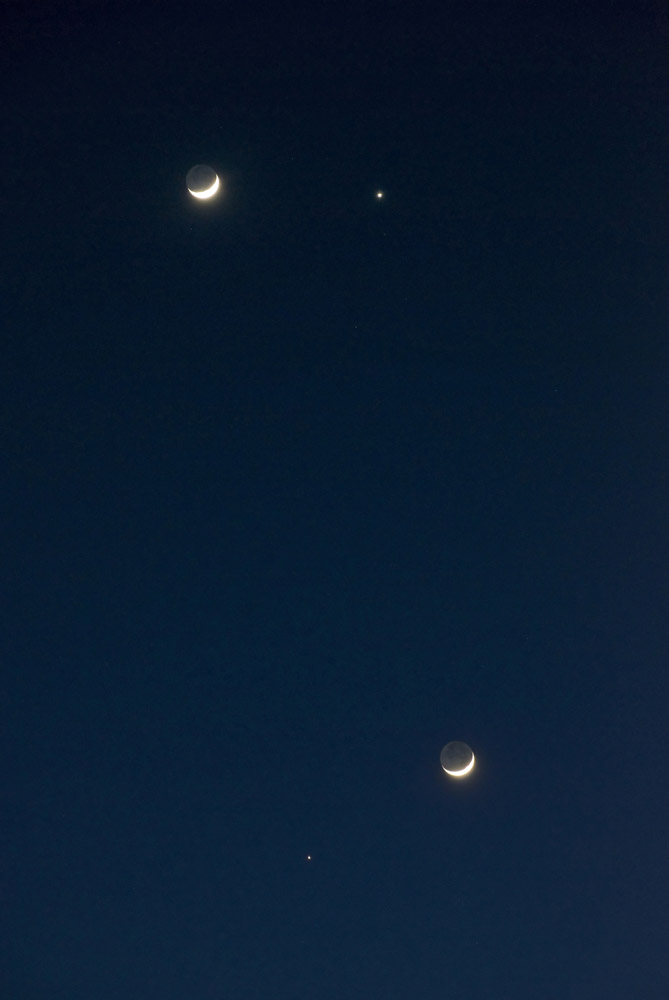Difference between revisions of "April 5, 2012"
| (5 intermediate revisions by the same user not shown) | |||
| Line 1: | Line 1: | ||
__NOTOC__ | __NOTOC__ | ||
=What a Difference a Day Makes, 24 Little Hours= | =What a Difference a Day Makes, 24 Little Hours= | ||
| − | + | <!-- Start of content --> | |
<!-- ws:start:WikiTextHeadingRule:0:<h1> --> | <!-- ws:start:WikiTextHeadingRule:0:<h1> --> | ||
| − | < | + | <table class="wiki_table"> |
| − | </ | + | <tr> |
| − | + | <td><!-- ws:start:WikiTextLocalImageRule:14:<img src="/file/view/LPOD-Apr5-12.jpg/317771378/LPOD-Apr5-12.jpg" alt="" title="" style="width: 500px;" /> -->[[File:LPOD-Apr5-12.jpg|LPOD-Apr5-12.jpg]]<!-- ws:end:WikiTextLocalImageRule:14 --><br /> | |
| − | + | </td> | |
| − | + | <td><em>image by [mailto:andrew_symes@yahoo.ca Andrew Symes], Ottawa, Ontario, Canada</em> <br /> | |
| − | + | <br /> | |
| + | Late last month the nightly movement of the Moon past the bright Venus and Jupiter generated much interest among the the public. My university office received calls about what was the bright object near the Moon. (I would say, <em>Oh, that is just Venus, the Moon is really the fascinating place - take a look at it with binoculars.</em>) Andrew captured two photos of the Moon one day apart - and then combined them into a single image that shows the Moon's movement (March 25, bottom right and March 26th, top left) relative to Venus (top) and Jupiter (below). Many people who saw the spectacle were surprised at just how much the Moon moves from one night to the next. But it does circle the world in one month so 360°/30 = 12°/day. Normally we don't have anything conspicuous to compare its movement to and don't notice the difference so dramatically. <br /> | ||
| + | <br /> | ||
| + | <em>[mailto:tychocrater@yahoo.com Chuck Wood]</em><br /> | ||
| + | <br /> | ||
| + | <strong>Related Links</strong><br /> | ||
| + | Andrew's astronomy [http://vimeo.com/failedprotostar videos]<br /> | ||
| + | <br /> | ||
| + | <hr /> | ||
| + | <p><b>Yesterday's LPOD:</b> [[April 4, 2012|Southwest Corner]] </p> | ||
| + | <p><b>Tomorrow's LPOD:</b> [[April 6, 2012|Domical Profiles]] </p> | ||
| + | <!-- End of content --> | ||
| + | {{wiki/ArticleFooter}} | ||
Latest revision as of 13:58, 8 February 2015
What a Difference a Day Makes, 24 Little Hours
 |
image by Andrew Symes, Ottawa, Ontario, Canada
Yesterday's LPOD: Southwest Corner Tomorrow's LPOD: Domical Profiles COMMENTS?Register, Log in, and join in the comments.
|



